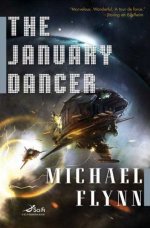
| The January Dancer | ||||||||
| Michael Flynn | ||||||||
| Tor, 350 pages | ||||||||
|
A review by Rich Horton
The story is framed as if told by a scarred man in a bar on the world Jehovah to a woman harper who wants to make
music of it. As with many frames (all the best frames), the telling of the story becomes part of the story, and is
important to understanding it -- indeed we guess soon enough that the teller and hearer have some connection to
the events of the main tale, though what connection takes some time to become clear. The story proper opens on a
deserted world, with Amos January's ship the New Angeles trying to find sufficient material to effect
repairs. In the process they stumble on a treasure trove, holding wonderful and mysterious objects that must
be "prehuman." Only one of these things is moveable, however -- a curious stone thing, that seems to alter its
shape when one isn't looking.
Eventually January and his crew escape with this item, that they call the "Slipstone," though others call it
the "Dancer" (hence the book's title). January hopes to sell it to the owner of the Interstellar Cargo Company (ICC),
famously a collector of prehuman artifacts.
But the story begins in several other places, now introducing the main characters. The world of New Eireann is
precariously terraformed, and events conspire so as to result in a rebellion, with Hugh O'Connell becoming the
leader of the resistance, earning the name Ghost of Ardow. But when ICC ships arrive to quell the trouble,
the New Angeles also happens along. And the ICC captain acquires the Dancer, which, it now appears,
gives its owner the power of command over anyone within their voice's range. O'Connell leaves New Eireann,
vowing to return. And some time later, he encounters a mysterious Terran called the Fudir, and between them
they end up planning to go back to New Eireann, steal the Dancer, and use it first to win back O'Connell's
planet, then to liberate long-oppressed Terra.
Meanwhile, at the outpost guarding the main pass across the Rift, a mystery has come to light. Sometimes ships
that cross the Rift don't return -- too many to explain by ordinary means. The Hound guarding this pass (a Hound
is a sort of super independent space policeman) sends four people out to investigate this anomaly, including
his chief "apprentice," or Pup, a colorless sort of man called Greystroke.
Before long Greystroke has tracked down the Fudir and Hugh, and he recognizes that the mystery of the Dancer
may be more important than his original assignment. But disaster has already struck: pirates have raided New
Eireann and stolen the Dancer.
Finally, another Hound, the beautiful Bridget Ban, has come to the quasi-independent planet Peacock Junction,
and she has uncovered another mystery. Also, it turns out, the pirates came to some trouble at Peacock Junction,
and the Dancer may be lost again. Eventually Bridget joins with Greystroke, the Fudir, and Hugh, which is an
arrangement that leads all to familiar human troubles before long. Anyway, they eventually find themselves
at the oldest human planet this side of the Rift, where they will encounter the head of the ICC, and also
the new owner of the Dancer, and where various further betrayals await -- and where a number of suddenly
intertwined mysteries will be resolved.
It's really quite cleverly put together, in the end. The solution to the central mystery -- the nature of
the Dancer -- is very satisfying, and is nicely tied in with the other mystery (the problems in the Rift) and
which other things like the history behind Flynn's future setup. I also greatly enjoyed such details as the
names of planets (like Dao Chetty, which it took me forever to realize was a corruption of Tau Ceti), and
the names of features like Electric
Avenue: the wormhole routes ships travel in this universe. The characters are a bit larger than
life -- all as intended I'm sure -- which sometimes works, but sometimes stretched my credulity a bit.
Things take a while to really get going, perhaps. The story seems needlessly obscure at times to begin
with, but trust Flynn -- things that don't make sense in the beginning often suddenly emerge later on as
key details. As I hinted, the prose is often very nice, but at times overcooked -- likewise the insistence
on a sort of mythical meaning to everything grates on occasion (though it can be explained by the manner
of telling). It's a very enjoyable novel in a rather old-fashioned mode -- but nonetheless not dated -- a
fine space opera with a quite satisfying central mystery, and with a setting that could be reused for
further worthwhile novels.
Rich Horton is an eclectic reader in and out of the SF and fantasy genres. He's been reading SF since before the Golden Age (that is, since before he was 13). Born in Naperville, IL, he lives and works (as a Software Engineer for the proverbial Major Aerospace Company) in St. Louis area and is a regular contributor to Tangent. Stop by his website at http://www.sff.net/people/richard.horton. |
|||||||
|
|
If you find any errors, typos or anything else worth mentioning,
please send it to editor@sfsite.com.
Copyright © 1996-2014 SF Site All Rights Reserved Worldwide
